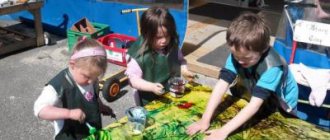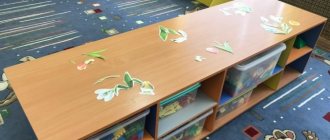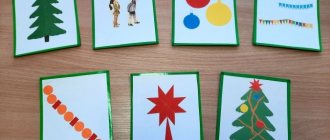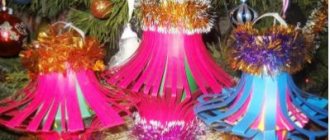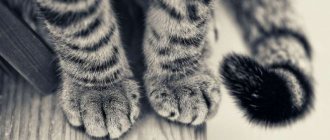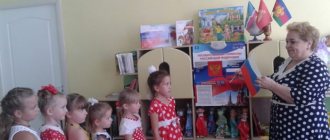Objectives of an individual lesson
| Educational objectives | Formation of the concept of the mechanism of sound formation and its acoustic features; formation or consolidation of knowledge about a syllable, a word, a sentence; consolidation of the dictionary or clarification of words containing a given sound on a lexical topic (this could be “Toys”, “Autumn”, “Shoes”, etc.) |
| Corrective tasks | Development and improvement of articulatory motor skills; formation of rules for oral exhalation taking into account this phoneme; development of phonemic hearing and voice; formation of conditioned reflex connections to a given articulatory-acoustic image |
| Educational tasks | Correction of the child’s personality as a whole. |
Below, I would like to present to you, dear colleagues, the structure of an individual lesson.
Summary of an individual speech therapy lesson in the preparatory group of a preschool educational institution with presentation
Summary of individual speech therapy sessions.
Topic: “Luntik’s birthday” Goal: automation of the sound “L” in syllables, words, sentences. Objectives: Correctional and educational:
To consolidate articulation and isolated pronunciation of the sound “L”.
Continue to learn how to correctly pronounce the sound “L” in syllables, words, and sentences. Continue to teach how to determine the presence of a sound in a word, the place of a sound in a word, and the ability to identify the first sound. Practice declension of nouns. Activate the vocabulary on the topics “Products”, “Toys”, the use of generalizing words. Practice agreeing nouns with the adjective “sweet”. Correctional and developmental:
Develop skills in sound analysis and synthesis.
Develop general, fine, articulatory motor skills. Develop the ability to systematize objects and justify your answer. Develop thinking, attention, spatial orientation skills. Develop tempo-rhythmic hearing. Reinforce knowledge of primary and shading colors. Develop phonemic awareness and coherent speech. Correctional and educational:
Develop self-control over speech.
Instill cultural and hygienic skills. Equipment: Multimedia presentation, did/manual “Airplane” (determining the place of a sound in a word), massage ball, ind. mirror, ball, object pictures for the game “Find a Pair”, cards for the game “Encrypted Word”, colored circles for visual gymnastics. Preliminary work: 1. Conducting did/games “Find a Pair”, “Encrypted Word” 2. Learning self-massage complexes.
3. Carrying out the games “Repeat the knock”, “Repeat the melody” 4. Working with deformed phrases. Progress:
I. Organizational moment. Speech therapist: I'll tell you a riddle about a cartoon character. Guess who we're talking about. “Once upon a time, an unusual baby was born on the moon. And it so happened that he fell to the ground. There he made many friends." Have you guessed who we're talking about? Child's answer. II. Installation for completing a task. Speech therapist: right, this is Luntik. Let's imagine that today is Luntik's birthday and see what interesting things happened on this day. But we will not only watch and complete tasks, but also remember the correct pronunciation of the sound “L”. Let's see how we pronounce the sound "L". What position are your lips in? (smiling) Where is the tongue? (behind the upper teeth). III. Main part . (with viewing a multimedia presentation) Speech therapist: Today is Luntik’s birthday. He got up early and washed himself thoroughly. Self-massage “Nose, wash your face!” is performed. 1. “Tap, open!” — with our right hand we make rotational movements, “opening” the tap. 2. “Nose, wash your face!” — rub the wings of the nose with the index fingers of both hands. 3. “Wash both eyes at once”—we gently move our hands over the eyes. 4. “Wash your ears!” - rub your ears with your palms. 5. “Wash yourself, neck!” - With gentle movements we stroke the front of the neck. 6. “Neck, wash yourself thoroughly!” - stroke the back of the neck, from the base of the skull to the chest. 7. “Wash, wash, bathe yourself! – Gently stroke the cheeks. 8. “Dirt, wash away! Dirt, wash away!” - three palms touching each other. Then Luntik decided to blow bubbles in the water. Breathing exercises “Bul-bulls” are being performed. I brushed my teeth thoroughly (exercise “Let’s brush my teeth”), combed my hair (exercise “Comb”), saw my favorite toys and decided to play with them a little. These were a horse (control "Horse") and an airplane (control "Airplane"). Then Luntik went outside and decided to ride on a swing (exercise “Swing”). Suddenly Luntik heard cheerful singing. It was the butterflies singing. He decided to sing with them. Let's sing along to the butterflies and Luntik. (singing syllables with the sound “L” 2 times) - La-la la-la-la - lo-lo-lo lo-lo - lu-lu lu-lu lu-lu-lu-lu-lu - ly-ly -ly-ly ly-ly-ly Speech therapist: All his friends came to visit Luntik: Mila, Kuzya, Little Bee, Uncle Shnyuk, Uncle Korney, Vupsen and Pupsen and even the toad Klava. Friends gave Luntik many gifts. Name these objects, clearly pronouncing the sound “L”. What objects do not have the sound “L” in their names? Determine the place of the sound “L” in the names of the pictures. The child determines the place of a sound in a word using the teaching aid “Airplane”. (jump rope, fins, pencil case, spinning top, elephant) - Tell me where each gift is. The game “Name where the object is” is played (the child names using the words “right”, “left”, “in front”, “behind”, “on”, “about”) - Luntik liked all the gifts. But he especially liked the elephant. Let's play the game "Give me a word." The game “Give me a word” is being played - Luntik saw... (an elephant). - Luntik approached ... (elephant). - He began to admire... (the elephant). - He never had such... (elephant). - When he goes to bed, he will think... (about the elephant). Gymnastics for the eyes “Multi-colored circles” (the child looks at the circle of the color that the speech therapist names) Speech therapist: Baba Kapa has prepared a treat. Let's name what she cooked. You need to say it in a complete sentence. Sample: “Baba Kapa prepared kalach.” etc. (kalach, bun, puff pastry, strawberry pie). Tell me what the strawberry pie will be called. (child’s answer) What do these products taste like? Correctly sweet. Let's say what kind of roll (sweet), bun (sweet), puff pastry (sweet), pie (sweet). Speech therapist: - What are all these products made from? (child's answer) That's right, from flour. When you add liquid to the flour and start mixing, you get a dough. Let's show how we "knead the dough." An exercise for the hands is carried out using a massage ball “Let's bake a loaf” - Knead, knead the dough (squeeze the massage ball in your right hand) There is a place in the oven (squeeze the ball in your left hand) Let's bake a loaf (roll the ball between your palms in a circular motion) Shift, come on (toss the ball from one hand to the other and squeeze it tightly) After the tasty treat, Mila suggested playing the game “Find a Pair.” You not only need to find pairs of objects, but also explain your choice. Make up sentences similar to the following: “I combined a horse and a donkey because they are domestic animals.” (pictures: beets, shovel, table, horse, bow, donkey, chair, saw.) The game “Find a Pair” is played. Speech therapist: Little Bee loves to write poetry. Today he composed a poem about Mila. The game “Echo” is played with throwing the ball. (The child repeats pure sayings after the adult) La-la-la - Mila helped her mother Lo-lo-lo - deftly washed the glass La-ly-ly - Mila washed the floors Lu-lu-lu - Mila weeded the onions Ala-ala-ala - ours Mila was embroidering Ola-ola-ola - Mila pricked her finger Ela-ela-ela - Mila's mother took pity on her. Speech therapist: And Kuzya came up with the game “Encrypted Word”. It is necessary to determine the first sound in the names of the pictures, then combining these sounds, we will find out which word is encrypted. (picture material: - chair, lamp, cloud, knives (elephant), - lily of the valley, corner, bee, shark (magnifying glass), - pencil case, needle, elk, cherry plum (saw) The game “Encrypted Word” is played Speech therapist: Vupsen and Pupsen are going to go to school. They already know how to write. Only what they write can’t always be understood. Let’s try to figure it out and make sentences correctly. - Make, Mila, Easter cakes, sand, from. - Help, Luntik, baba, Capa. - Butterfly, catch, Luntik, net. - Little bee, Kuzya, and, football, play. IV. Final part. Speech therapist: So Luntik’s birthday has come to an end. You completed all the tasks. What do you remember and Did you like it?
Presentation on the topic: Individual speech therapy session Luntik’s birthday
We recommend watching:
Summary of GCD in a compensatory preparatory group with severe speech impairments Synopsis of an integrated lesson in a preparatory group with general underdevelopment of speech of the third level Synopsis of GCD in a preparatory group on the topic: Pisces Summary of GCD on speech development on the topic: Winter in a preparatory speech therapy group
Similar articles:
Lesson summary – travel on the topic “School” in the preparatory group
Summary of the lesson “Take care of nature” in the preparatory group
The structure of an individual lesson at the stage of sound production
- Organizing time
- Articulation exercises: general articulation exercises, special articulation exercises, exercises to develop the strength of the voice and exhalation.
- Announcing the topic of the lesson to the child.
- Sound production (by imitation, from a preserved phoneme, from articulation exercises, by mechanical influence).
- Analysis of articulation according to plan: position of the lips, position of the teeth, position of the tongue (tip, back, root), participation of the vocal folds, nature of the exhaled stream.
- Consolidating isolated sound: pronunciation, onomatopoeia games.
- Development of phonemic hearing: sound recognition in a series of isolated sounds, distant in articulatory and acoustic characteristics, in syllables, taking into account the above recommendations, in words, in sentences, in text.
- Consolidating the pronunciation of sounds in words.
- Homework.
- Result of the lesson: repetition of which sound was practiced during the lesson, analysis of the main provisions of the articulation of the sound being studied, final pronunciation.
- Assessment of a child’s work in class is carried out with a positive psychological focus.
And in conclusion, I would like to note that when preparing and conducting an individual lesson, it is very important to remember that throughout the entire lesson the child must maintain a strong positive emotional attitude, which is expressed in the desire to study. This is achieved by using surprise moments, game fragments, exciting tasks and exercises, during which the learning process turns into an interesting game.
